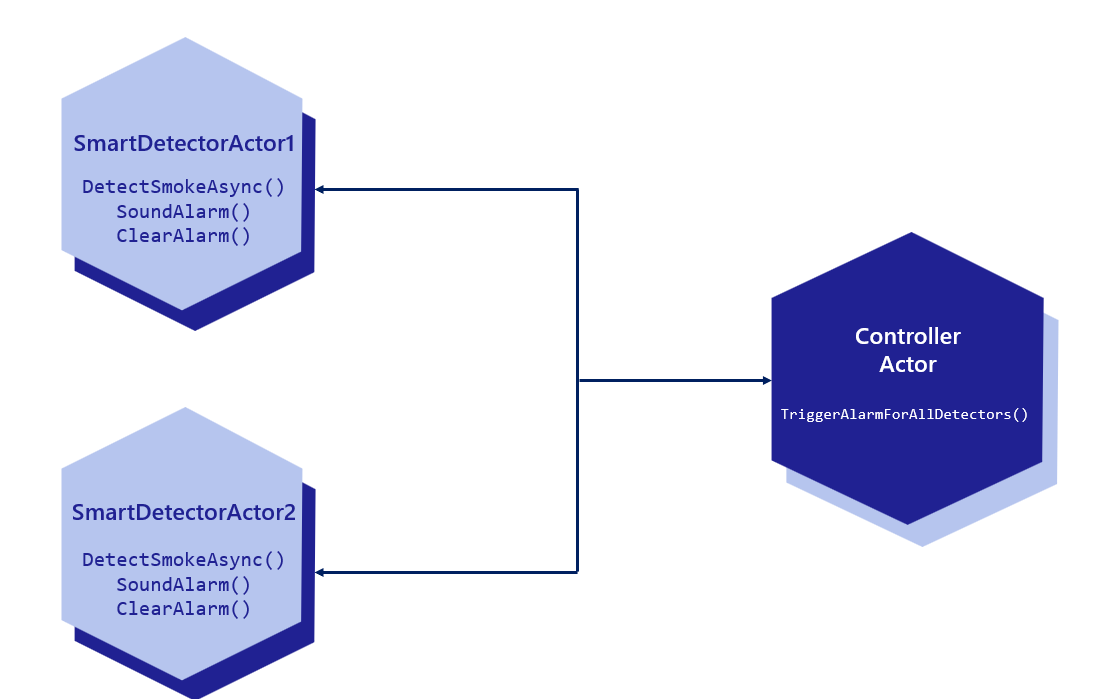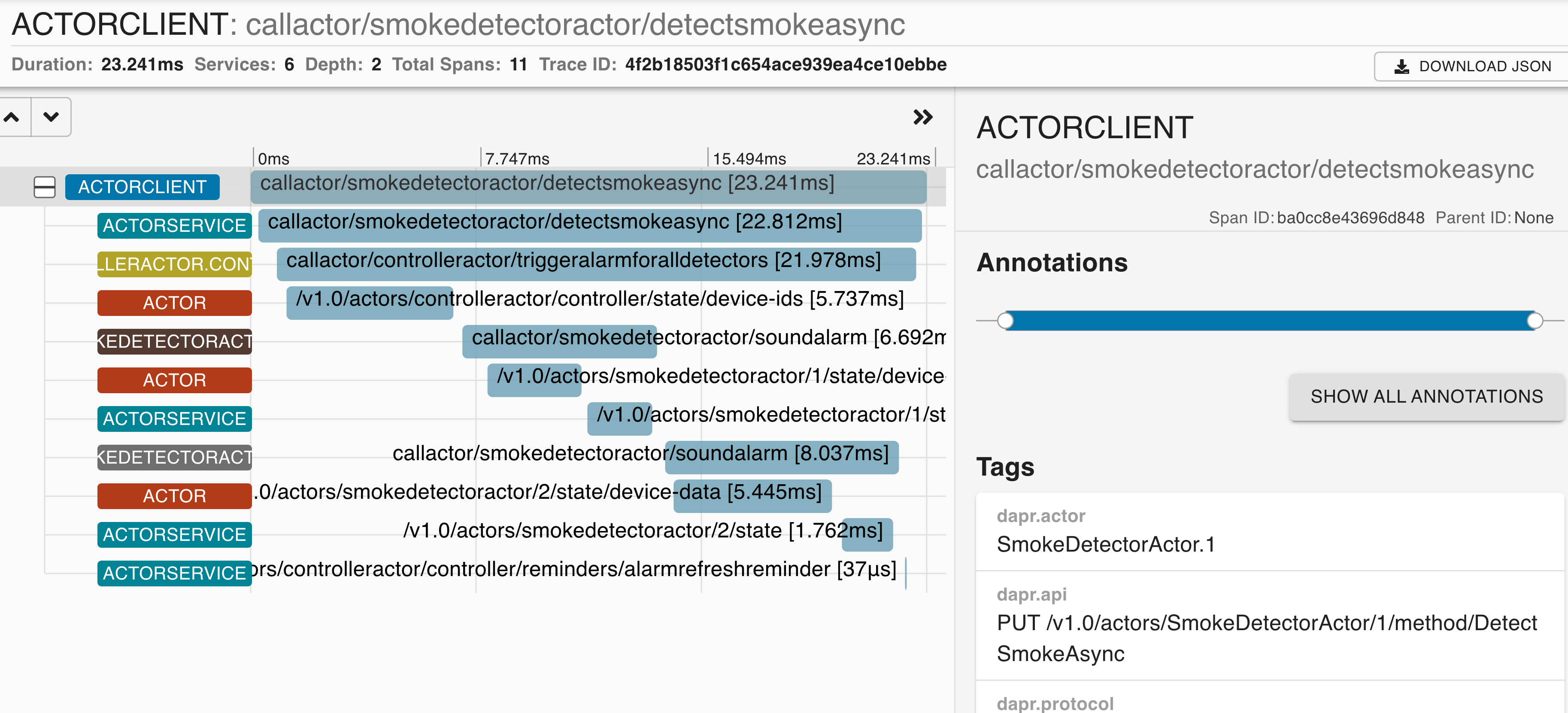The documentation you are viewing is for Dapr v1.11 which is an older version of Dapr. For up-to-date documentation, see the latest version.
Quickstart: Actors
Let’s take a look at Dapr’s Actors building block. In this Quickstart, you will run a smart device microservice and a simple console client to demonstrate the stateful object patterns in Dapr Actors.
Currently, you can experience this actors quickstart using the .NET SDK.
As a quick overview of the .NET actors quickstart:
- Using a
SmartDevice.Servicemicroservice, you host:- Two
SmartDectectorActorsmoke alarm objects - A
ControllerActorobject that commands and controls the smart devices
- Two
- Using a
SmartDevice.Clientconsole app, the client app interacts with each actor, or the controller, to perform actions in aggregate. - The
SmartDevice.Interfacescontains the shared interfaces and data types used by both the service and client apps.

Pre-requisites
For this example, you will need:
Step 1: Set up the environment
Clone the sample provided in the Quickstarts repo.
git clone https://github.com/dapr/quickstarts.git
Step 2: Run the service app
In a new terminal window, navigate to the actors/csharp/sdk/service directory and restore dependencies:
cd actors/csharp/sdk/service
dotnet build
Run the SmartDevice.Service, which will start service itself and the Dapr sidecar:
dapr run --app-id actorservice --app-port 5001 --dapr-http-port 3500 --resources-path ../../../resources -- dotnet run --urls=http://localhost:5001/
Expected output:
== APP == info: Microsoft.AspNetCore.Hosting.Diagnostics[1]
== APP == Request starting HTTP/1.1 GET http://127.0.0.1:5001/healthz - -
== APP == info: Microsoft.AspNetCore.Routing.EndpointMiddleware[0]
== APP == Executing endpoint 'Dapr Actors Health Check'
== APP == info: Microsoft.AspNetCore.Routing.EndpointMiddleware[1]
== APP == Executed endpoint 'Dapr Actors Health Check'
== APP == info: Microsoft.AspNetCore.Hosting.Diagnostics[2]
== APP == Request finished HTTP/1.1 GET http://127.0.0.1:5001/healthz - - - 200 - text/plain 5.2599ms
Step 3: Run the client app
In a new terminal instance, navigate to the actors/csharp/sdk/client directory and install the dependencies:
cd ./actors/csharp/sdk/client
dotnet build
Run the SmartDevice.Client app:
dapr run --app-id actorclient -- dotnet run
Expected output:
== APP == Startup up...
== APP == Calling SetDataAsync on SmokeDetectorActor:1...
== APP == Got response: Success
== APP == Calling GetDataAsync on SmokeDetectorActor:1...
== APP == Device 1 state: Location: First Floor, Status: Ready
== APP == Calling SetDataAsync on SmokeDetectorActor:2...
== APP == Got response: Success
== APP == Calling GetDataAsync on SmokeDetectorActor:2...
== APP == Device 2 state: Location: Second Floor, Status: Ready
== APP == Registering the IDs of both Devices...
== APP == Registered devices: 1, 2
== APP == Detecting smoke on Device 1...
== APP == Device 1 state: Location: First Floor, Status: Alarm
== APP == Device 2 state: Location: Second Floor, Status: Alarm
== APP == Sleeping for 16 seconds before checking status again to see reminders fire and clear alarms
== APP == Device 1 state: Location: First Floor, Status: Ready
== APP == Device 2 state: Location: Second Floor, Status: Ready
(Optional) Step 4: View in Zipkin
If you have Zipkin configured for Dapr locally on your machine, you can view the actor’s interaction with the client in the Zipkin web UI (typically at http://localhost:9411/zipkin/).

What happened?
When you ran the client app, a few things happened:
-
Two
SmartDetectorActoractors were created in the client application and initialized with object state with:ActorProxy.Create<ISmartDevice>(actorId, actorType)proxySmartDevice.SetDataAsync(data)
These objects are re-entrant and hold the state, as shown by
proxySmartDevice.GetDataAsync().// Actor Ids and types var deviceId1 = "1"; var deviceId2 = "2"; var smokeDetectorActorType = "SmokeDetectorActor"; var controllerActorType = "ControllerActor"; Console.WriteLine("Startup up..."); // An ActorId uniquely identifies the first actor instance for the first device var deviceActorId1 = new ActorId(deviceId1); // Create a new instance of the data class that will be stored in the first actor var deviceData1 = new SmartDeviceData(){ Location = "First Floor", Status = "Ready", }; // Create the local proxy by using the same interface that the service implements. var proxySmartDevice1 = ActorProxy.Create<ISmartDevice>(deviceActorId1, smokeDetectorActorType); // Now you can use the actor interface to call the actor's methods. Console.WriteLine($"Calling SetDataAsync on {smokeDetectorActorType}:{deviceActorId1}..."); var setDataResponse1 = await proxySmartDevice1.SetDataAsync(deviceData1); Console.WriteLine($"Got response: {setDataResponse1}"); Console.WriteLine($"Calling GetDataAsync on {smokeDetectorActorType}:{deviceActorId1}..."); var storedDeviceData1 = await proxySmartDevice1.GetDataAsync(); Console.WriteLine($"Device 1 state: {storedDeviceData1}"); // Create a second actor for second device var deviceActorId2 = new ActorId(deviceId2); // Create a new instance of the data class that will be stored in the first actor var deviceData2 = new SmartDeviceData(){ Location = "Second Floor", Status = "Ready", }; // Create the local proxy by using the same interface that the service implements. var proxySmartDevice2 = ActorProxy.Create<ISmartDevice>(deviceActorId2, smokeDetectorActorType); // Now you can use the actor interface to call the second actor's methods. Console.WriteLine($"Calling SetDataAsync on {smokeDetectorActorType}:{deviceActorId2}..."); var setDataResponse2 = await proxySmartDevice2.SetDataAsync(deviceData2); Console.WriteLine($"Got response: {setDataResponse2}"); Console.WriteLine($"Calling GetDataAsync on {smokeDetectorActorType}:{deviceActorId2}..."); var storedDeviceData2 = await proxySmartDevice2.GetDataAsync(); Console.WriteLine($"Device 2 state: {storedDeviceData2}"); -
The
DetectSmokeAsyncmethod ofSmartDetectorActor 1is called.public async Task DetectSmokeAsync() { var controllerActorId = new ActorId("controller"); var controllerActorType = "ControllerActor"; var controllerProxy = ProxyFactory.CreateActorProxy<IController>(controllerActorId, controllerActorType); await controllerProxy.TriggerAlarmForAllDetectors(); } -
The
TriggerAlarmForAllDetectorsmethod ofControllerActoris called. TheControllerActorinternally triggers all alarms when smoke is detectedpublic async Task TriggerAlarmForAllDetectors() { var deviceIds = await ListRegisteredDeviceIdsAsync(); foreach (var deviceId in deviceIds) { var actorId = new ActorId(deviceId); var proxySmartDevice = ProxyFactory.CreateActorProxy<ISmartDevice>(actorId, "SmokeDetectorActor"); await proxySmartDevice.SoundAlarm(); } // Register a reminder to refresh and clear alarm state every 15 seconds await this.RegisterReminderAsync("AlarmRefreshReminder", null, TimeSpan.FromSeconds(15), TimeSpan.FromSeconds(15)); }The console prints a message indicating that smoke has been detected.
// Smoke is detected on device 1 that triggers an alarm on all devices. Console.WriteLine($"Detecting smoke on Device 1..."); proxySmartDevice1 = ActorProxy.Create<ISmartDevice>(deviceActorId1, smokeDetectorActorType); await proxySmartDevice1.DetectSmokeAsync(); -
The
SoundAlarmmethods ofSmartDetectorActor 1and2are called.storedDeviceData1 = await proxySmartDevice1.GetDataAsync(); Console.WriteLine($"Device 1 state: {storedDeviceData1}"); storedDeviceData2 = await proxySmartDevice2.GetDataAsync(); Console.WriteLine($"Device 2 state: {storedDeviceData2}"); -
The
ControllerActoralso creates a durable reminder to callClearAlarmafter 15 seconds usingRegisterReminderAsync.// Register a reminder to refresh and clear alarm state every 15 seconds await this.RegisterReminderAsync("AlarmRefreshReminder", null, TimeSpan.FromSeconds(15), TimeSpan.FromSeconds(15));
For full context of the sample, take a look at the following code:
SmartDetectorActor.cs: Implements the smart device actorsControllerActor.cs: Implements the controller actor that manages all devicesISmartDevice: The method definitions and shared data types for eachSmartDetectorActorIController: The method definitions and shared data types for theControllerActor
Tell us what you think!
We’re continuously working to improve our Quickstart examples and value your feedback. Did you find this Quickstart helpful? Do you have suggestions for improvement?
Join the discussion in our discord channel.
Next steps
Learn more about the Actor building block
Explore Dapr tutorials >>Feedback
Was this page helpful?
Glad to hear it! Please tell us how we can improve.
Sorry to hear that. Please tell us how we can improve.